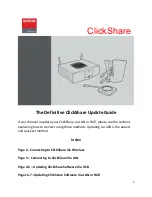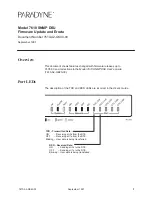
FAAST 8251BPI and 8100
INSTALLATION AND MAINTENANCE INSTRUCTIONS
11
Figure 12: IP Address Blink Mode
Figure 13: IP Address Indicator Lights
IP Address Blink Mode
If the device IP has been lost or is unavailable, it is
possible to obtain the address using the IP address blink
mode. The IP address can be accessed from the user
interface by pressing and holding the MODE/RESET
button for 30 seconds. The digits are displayed using the
method as described in the Address Blink mode, except
that the FAULT and LOW VOLTAGE indicators are used
to show the 1st and 12th digit, respectively. The device
gives the 12 digit number by illuminating the particulate
bar graph to the appropriate number of segments for
each digit, as shown in Figure 12. This example shows
that the 5th number of the IP address is 7. The current
digit displayed is indicated by the FAULT, FLOW /
FAULT and VOLTAGE indicators (Figure 13) starting with
the FAULT for the 1st digit, progressing through the
HIGH FLOW, and ending with the LOW VOLTAGE for
the 12th digit. If one of the numbers is zero, then no lights
will illuminate for that number on the particulate graph.
The device will return to Normal operating mode.
Real-Time Clock
The unit is equipped with a real-time clock and power
supply that allows the FAAST system to maintain the
date and time for up to 72 hours after a loss of power.
Date and time are configured through PipeIQ. The real-
time clock is used to maintain a time base for the device.
This time base is used to time stamp all log entries, as
well as determine when it is time to transfer from Day,
Night and Weekend modes. If the device loses power for
more than 72 hours the device sets the TIME fault
indicating the time needs to be updated.
Logs
Event Log
The FAAST system is equipped with internal memory
that can be configured to log detector events. Up to
18,000 events can be stored. Events that are tracked
include Alarms, Faults and User Actions. Event tracking
data may be accessed via the network through the
PipeIQ software or the Web server interface.
Configuration and management of the log are done using
the PipeIQ software.
Data Trend Log
The FAAST system tracks trend data for each 24 hour
time period, up to 1 year. The device records the
minimum, maximum and average reading of the sensor
and flow values for each day.
Message Log
The message log allows the user to enter generic text
messages into the system’s memory. Messages may be
retrieved for viewing at a later time. These messages
may be used to track service history, configuration
changes, etc. 300 messages maximum may be stored.
External Monitor / Reset
The FAAST 8100 has an external monitor that can detect
an open or short when the 47KΩ End of Line resistor
supplied is used. When the device senses an open-circuit
it sets the External Monitor fault indicator and sets the
Minor Fault relay. When a short-circuit is detected the
device performs a Reset, providing the ability to Reset
latched Alarms remotely.
Ethernet Connection
The FAAST is a network capable device compatible with
standard Ethernet networking equipment. Connectivity is
provided by an on-board RJ45 connector located on the
base of the unit
– refer to Figure 15.
The network
interface is required for initial configuration of the FAAST
8100.
Once initial setup is complete, the Ethernet
connection provides optional remote access, monitoring
and email notification using
the unit’s Web server and
SMTP client.












































